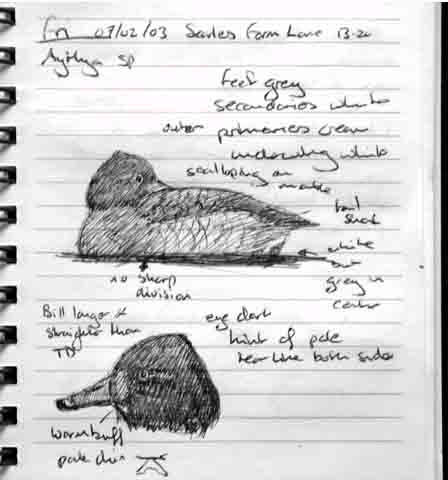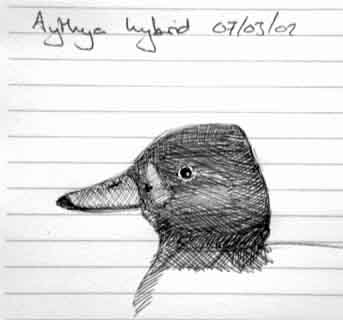Aythya Hybrid at Burghfield GP
8 Feb 2003 | Paul Bright-Thomas
Searle's Farm Lane 13:20-14:00 7th February 2003.
Viewed at approximately 50m (30x Swarovski scope).
Weather: Dull, cloudy, no wind, very flat light.
Aythya duck in female-type plumage in company with 15+ Tufted Ducks, at western end of pit north of public footpath. Initially mostly sleeping, but eventually awoke and swam across to far bank where perched on submerged branch, preened and resumed sleeping. Attracted attention due to head shape, paler colouration, facial pattern and dark iris with pale eye-ring. Resembled Tufted Duck (A. fuligula), but different head-shape, colouration and face-pattern.
Much the same size and shape as accompanying Tufted Duck, but when sleeping head showed bump at rear of crown, initially suggesting Ring-necked Duck (A. collaris). Also paler in colour than most Tufted Ducks, with pale grey-brown feather edges forming scalloping on back, and similar scalloping along paler greyish flanks. Breast warm earth-brown but with no sharp division from flanks. Tertials and rear of upper parts dull darker brown, contrasting with paler rear flanks. Tail short, held clear of water. Undertail coverts whitish around edges forming ring around grey centre to under-tail.
Head dull dark brown, slightly warmer and less uniform than most Tufted Ducks. Suggestion of paler patch on cheek and darker around neck between head and breast. Head-shape more triangular than the rounded shape of Tufted Duck, with straighter forehead, and straighter nape, fuller at the base of the nape. Bump on rear crown behind eye made a corner rather than projecting either vertically or horizontally. No sign of tuft. Head shape did not resemble Ring-necked Duck, which usually appears rather "tall" due to the raised crown ending abruptly giving a long almost straight profile to the back of the head.
Conspicuous warm buff loral ovals (slightly narrower at top), separated from bill base by narrow strip of dark feathering. Spots coming no lower than lower edge of bill, and reaching to level with top of eye, diverging above bill, rather than curving over to make a pale bill sourround.
Iris dark, contributing to different "look" from Tufted Ducks. Narrow pale eye ring and faint pale "tear-line" behind eye and curvnig down slightly. Brown of head slightly paler and warmer on cheeks. Whitish buff on sides of chin, making a small inverted V below bill.
Bill generally blue-grey as tufted duck, but with less distinct pale blue-grey sub-terminal band and dark grey tip. Some darker mottling along top surface and around bill base. Dark along cutting egde. Bill slightly longer and more wedge-shaped than Tufted Duck, with fairly straight lower edge. Feet grey.
Wing seen only partially extended; inner secondaries white and outer primaries creamy white. Underwing predominantly white.

Fig 1. Field sketch of Aythya hybrid 7th February 2003

Fig 2. Head detail of Aythya hybrid 7th February 2003
Concluded identification as hybrid Aythya sp., most probably Pochard x Tufted Duck, based on intermediate bill and head shape, and paler colouration than Tufted Duck. Ring-necked Duck eliminated on size, head shape, bill size, shape and pattern, face pattern, and pale primaries. Lesser Scaup eliminated by general size and shape, extensive dark tip and pale subterminal band on bill, pale eye-ring and tear line, pale primaries.
The bird could possibly be the same presumed hybrid Aythya sp. as observed at Burghfield Mill on 5th November 2002, sharing the buffy spots between bill and eye, although the earlier bird gave a more Scaup-like impression and was recorded as having dull golden eye.
© 2003 Paul Bright-Thomas